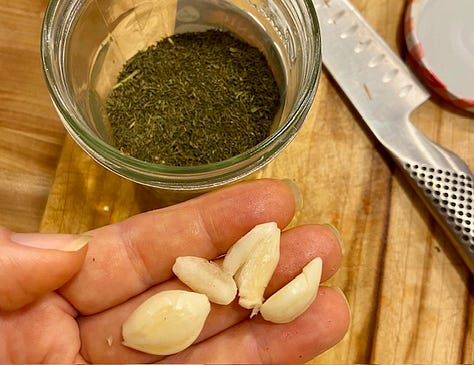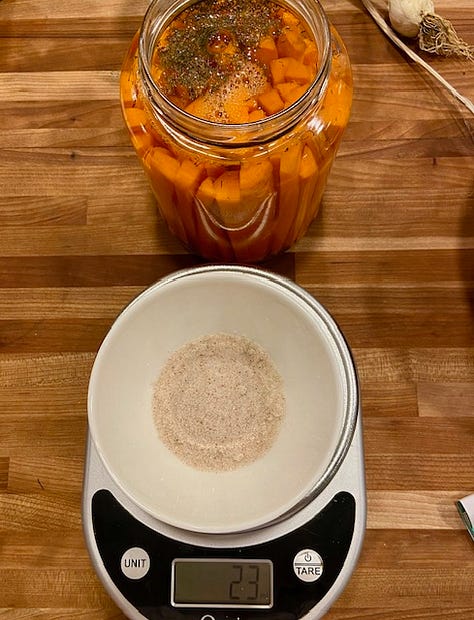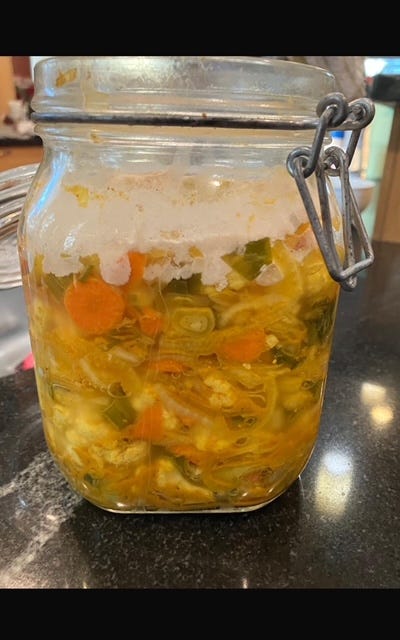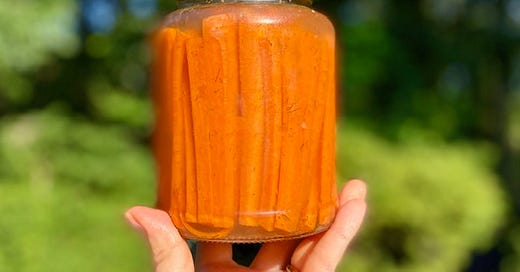If you’ve wanted to dip a toe into fermentation but felt intimidated, here’s your chance to overcome! You likely have everything needed.
If you can cut carrots, make these easy fermented dilly carrots in about 5 minutes of active time. Kids love them. Slightly sour, sometimes fizzy and still crunchy. Pack them into a lunchbox for a sneaky gut health boost. Serve with hummus or ranch. Or just eat with a sandwich.
Ingredients
carrots*
sea salt**
water without chlorine
1 tsp dried or fresh dill, garlic, ginger or any spices
glass jar
bonus but not necessary: digital scale
*I don’t recommend baby carrots which are washed in diluted bleach as part of the processing. Bleach inhibits growth of good bacteria too. Some people don’t peel their carrots. I prefer peeling simply because it makes a nicer presentation. I don’t peel when I’m cooking carrots.
**Kosher salt works. I prefer the extra minerals from sea salt as well as the taste of sea salt. Make sure it is free of anti-caking agents, which will inhibit fermentation. Ask me how I know…



Cut carrots to height of jar, leaving room so that water will cover them sufficiently. Stuff them in a jar. Really stuff them so they’re packed together and will stay submerged.
Instructions Without a Scale
Make brine in a measuring cup or jar: add 2 cups of water (without chlorine, which inhibits fermentation). Then add 2 tablespoons of sea salt, flat not rounded. Stir the mixture until salt is mostly dissolved. It will continue to dissolve once you pour over carrots.
Pour this mixture over the carrots. I prefer to put spices, if using, under the carrots.
Instructions With a Scale
Tare the jar, weigh in grams. Fill with dill (and garlic or ginger if wanted) then carrots, then filtered water. Weigh.
Multiply by 0.025 (which is 2.5%). Add that much sea salt. Put on the lid and shake to dissolve salt. You can use 3% if your kitchen is warm (75* or more).
The same can be done with cucumbers to make old fashioned pickles. They need more salt 3-4% brine. I prefer to add an oak tree leaf or horseradish leaf for tannins to help them stay crunchy.
Let it sit.
I use masking tape on the jar and write the date, and percentage of brine. This isn’t 100% necessary but I usually have a lot going on in my kitchen and can’t remember all the things.
About the 24-36 hour mark you will begin to notice evidence of fermentation. When you rotate or slightly shake the jar you will notice small bubbles rising from the bottom. Usually ferments are most active in the 24-48 hour window.
Feel free to open the jar and begin tasting. Be mindful that once a carrot is removed it might cause the others to float. You could add more carrots at this point. Or, I’ve used carrots across the top to keep the others submerged. Just play with it.
Under the brine is fine.
Try to keep everything submerged as much as possible. The brine will inhibit the growth of bad bacteria.
My kitchen is 73-76 degrees and I refrigerate after 3-5 days at room temp. The longer they sit at room temp the more sour they become. Some people let them sit 2 weeks. If you’re trying this in winter, definitely let them sit longer. Cooler temps slow the process way down.
In summers past, I have used a cooler with a bottle of frozen water to lower the temp a smidge. Our house in Little Rock was older and kitchen much warmer so I was constantly fighting kahm yeast (see more below). I’m trying something new this summer. I place the fermentation jars on the floor near the air conditioning vent. Cold air blows on them!
The happiest fermentation is about 68-72*.
I made sauerkraut earlier this summer and let it sit out a week then transferred it to my basement (~65*?) for a week then refrigerated.
Fermentation continues in the refrigerator, just slows everything way down.
What could go wrong?
A friend posted the below pictures in a group chat this week.


I replied:
Looks like kahm yeast to me. It’s harmless though smells weird. Google to read more about it. I think it also has a weird taste = harmless still not my fav. I’ve scraped it off and eaten before. Or, in the case of carrots— put in a strainer and rinse then have everyone eat the entire jar just to be done with it. It’s my experience this happens when my kitchen is on the warm side and/or I’m not using enough salt. Rule of thumb is use more salt in warmer months. It’s frustrating when it happens. Notice the temperature and how long it sat. The next time it’s that warm, refrigerate sooner.
This is a reason why some people use starter cultures (to get a jump start on kahm & over populate with other good guys). And why store bought ferments are expensive. It’s an art & not always science. Or maybe too much science!
If you see black fuzzy mold then toss.
What about the liquid when we’ve finished the carrots?
It’s still rich in nutrients, enzymes and probiotics. You could use in salad dressings or in soups (once in the bowl; heat in the pot will kill the probiotcis). Or my personal fav is dilute it and pour over my plants indoors and out.
If you’re not gonna make these, consider buying one of these four foods to improve gut health.
Life is hard; food doesn’t have to be.
Julie




